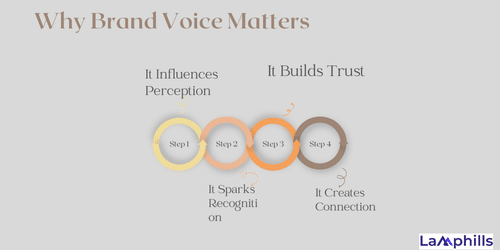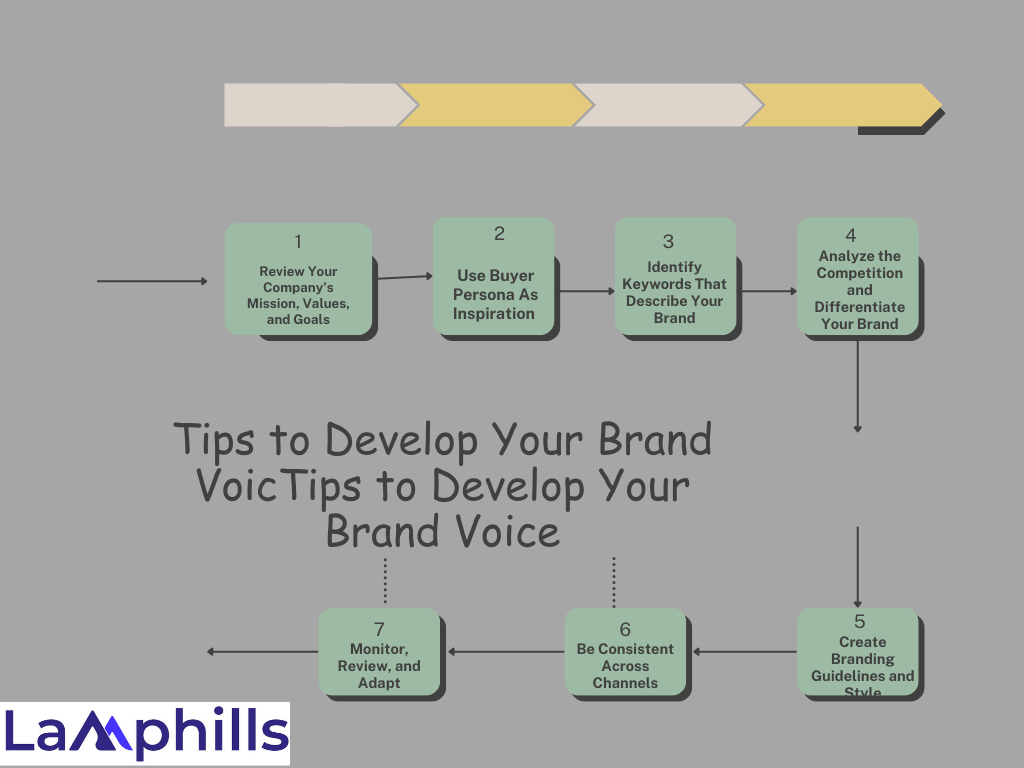I was at a marketing conference where I listened to a Nike speaker. As she detailed the company’s communication strategy, I realized that every piece of the message felt like a pep talk from a coach who believes in you. This was more than just advertising; it was an examples of a well-crafted brand voice that energized and inspired.
Similarly, personality makes you unique—a differential that doesn’t only apply to people. In an information-rich environment, brand voices will help any organization stand out. After all, in today’s competitive marketing scene, it’s simple to get lost in the mix, potentially costing your company and income as clients migrate to other organizations.
Now that you understand the necessity of a brand voice, you might be wondering where to begin. Fortunately, there are several brand voice examples from other firms to use as inspiration for creating your own. In this article, I’ll look at some of the best and most effective brand voice examples from top firms, evaluating how they create a distinct voice that is consistent with their mission.
Key Takeaways
- A unique and consistent brand voice is crucial in setting a company apart in a crowded market. It not only makes a brand recognizable but also influences how consumers perceive and engage with it. Companies like Nike and Wendy’s have effectively used their distinct voices to create memorable and impactful identities.
- A well-crafted brand voice significantly impacts how a brand is perceived and recognized. For instance, the inspirational voice of Adidas and the joyful, inclusive voice of Coca-Cola not only enhance brand recognition but also shape the overall reputation of the brands in the minds of consumers.
- Maintaining a consistent brand voice across all communication channels is essential, but it also requires periodic reviews and adaptations to stay relevant. Brands like Old Spice have successfully evolved their voice over time to remain memorable and effective, showing the importance of balancing consistency with adaptability.
- While your brand voice should remain consistent, you can update your brand’s personality over time. Consider making a few changes every five years or so to bring your brand voice up to speed. Doing so can help keep loyal customers interested and encourage business from new ones.
What Exactly is Brand Voice?

Brand voice is the evident and distinct personality your brand adopts in all communications, serving to portray you in a specific way to your customers. Simply put, brand voice refers to a company’s unique manner of communicating with its audience. Your brand’s personality is represented through written and spoken words.
The brand voice determines how your audience perceives you and their engagement. While brand tone might vary based on the context (a serious tone for a press release vs. a fun tone for a social media post), the brand voice is consistent, ensuring that all communication seems to come from the same source. As a distinguishing feature of your marketing plan, it enables you to connect with a specific audience that desires or requires what your company has to offer.
Why Brand Voice Matters

Morgan Brown, a marketer, believes that brands that speak to everyone talk to nobody. “Whether brand differentiation means what the brand stands for, the way the product is made, or the way they engage their audience, consumers are looking for differentiated experiences and brands they can connect to.”
Creating your brand voice will distinguish your company from the competitors, even if you operate in comparable product categories or sell the same products. It can influence how customers see your company, foster trust, forge connections, or help them find your voice among the noise.
#1. It Influences Perception
You’ll want your brand to have a positive reputation overall, but your company’s brand voice also has a hand in exactly how it’s perceived by consumers. Your brand might be known for its methodical research, eco-friendly ingredients, or inspiring slogan. For example, Adidas uses its voice to inspire consumers. It hints that customers can overcome the impossible.
#2. It Sparks Recognition
You already know the Nike swoosh and “Just do it” slogan, which has become just as recognizable as the Nike logo and name. Anywhere, any time consumers see that slogan, there’s instant awareness and recognition that the ad belongs to Nike. While this is true for the slogan, it’s also true for the brand’s larger aspirational voice.
#3. It Builds Trust
Whether you determine your brand’s voice to be sassy, supportive, or serious, it always needs to act as a vehicle to build trust with your customers. You don’t want to be labeled as the goofy friend that never follows through. Instead, use your voice to reassure customers that you’ll stay true to any brand promises.
#4. It Creates Connection
By following this checklist below, you can effectively conduct audience research to inform and refine your brand voice from the examples, ensuring it aligns with your target audience’s preferences and expectations.
A connection with your brand is what keeps customers coming back for more. For example, customers might feel a connection to brands that share similar values to them. A customer might subscribe to a business that produces recycled paper products because of their commitment to sustainability. Or, a customer might be loyal to local family-run businesses because they feel a direct connection to the owners.
Even if you can’t speak directly to customers in a retail setting, your goal is to make them feel like you are. How can your brand’s voice feel similar to your favorite barista at the local coffee shop?
Examples of Brand Voice
I’ve established why brand voice is important, but what does a good brand voice look like in practice? Let’s take a look at the examples of brands that have perfected their brand voice.
#1. Adidas
Adidas ranks first on my examples of brand voice. As one of the world’s most popular sportswear brands, Adidas understands how to attract and retain customers. Adidas’ brand message is built on empowering customers to pursue their aspirations. With Adidas on your side, you can accomplish everything you set your mind — and body — to.
Adidas’ motivational and encouraging marketing voice offers customers the impression that with the brand’s clothing and shoes, they have all they need to achieve their goals. Whether you’re training for a marathon or have just begun jogging, Adidas is here to help you do the impossible.
#2. Patagonia
Patagonia is next in my list of brand voice examples. Well-known for its highly durable and ecological outdoor gear, and its brand voice clearly communicate its ideals. Every communication refers to its efforts to increase environmentally friendly measures to mitigate the effects of climate change.
Unlike some brands that make it appear as if they care about the environment to attract customers, Patagonia has a proven track record of environmental activism, which is reflected throughout its brand language.
Much of the brand’s marketing promotes the idea of reusing and repurposing garments rather than purchasing new things. Patagonia’s most renowned campaign is “Don’t Buy This.” Jacket” advertisement, which told customers not to buy the brand’s most popular jacket at the time. Instead, it gave them green alternatives — reduce, repair, reuse, or recycle.
#3. Dove
Dove’s brand voice, as one of the top examples on my list, serves as a reassuring and empowering beacon in the marketing landscape. It is a wonderful example of how to properly connect with a target group, with its roots in decades-old messaging of self-worth and strength. The brand actively promotes good body image and confidence, exuding a relaxing, supporting, and welcoming vibe – attitudes that are consistent with the effects of its products.
Furthermore, Dove’s dedication to diversity predates its mass marketing adoption, demonstrating forethought and a willingness to take risks. This fearlessness has undoubtedly worked to help the brand become a household name, and few others have such a strong relationship with customers. Notably, the brand’s consistency in championing inclusivity has contributed to its enduring popularity.
In a world where authenticity matters, Dove’s brand voice is more than a marketing tactic; it is a commitment to true social change and celebration of diverse beauty. Simply put, Dove’s brand voice stands out as a genuine ally to its audience, making it a trailblazer in the realm of purpose-driven branding.
#4. Coca-Cola
Coca-Cola provides another excellent example of brand voice. Its brand voice is a masterpiece in conveying a sense of community and inclusivity, resulting in a resonant and globally recognized identity that is reflected in its compelling communication.
Coca-Cola always creates a sense of enthusiasm, whether through festive holiday advertisements showing arctic creatures or carefree folks dancing and celebrating. This method has been extremely effective, as indicated by the brand’s iconic status and worldwide popularity.
However, Coca-Cola’s brand voice is more than merely upbeat; it is strategic and effective. For example, the “Share a Coke” campaign, which included unique names on bottles, resulted in a huge increase in consumer interaction. This tailored approach not only enhanced sales but also strengthened the emotional connection with customers.
Coca-Cola is also exceptionally adept at taking advantage of seasonality. Everyone who’s heard of Coca-Cola is more than familiar with its winter season campaigns, which are meticulously crafted and synonymous with holiday cheer. The company’s emphasis on positive emotions and community is its bread and butter and a testament to the enduring power of crafting a resonant and emotionally impactful identity.
#5. Apple
Apple is one of the most successful brand voice and tone examples for conveying luxury. Its technological innovations and cutting-edge services are presented with an appearance of exclusivity and high prestige, backed up by a sense of earned confidence.
Apple’s impact over the past two decades has been astonishing. The company has the most loyal smartphone users in the United States, with 93% of iPhone owners sticking with the brand through consecutive generations of smartphones.
Its marketing efforts feature brief, aggressive, and declarative remarks. They undoubtedly have a role in customer retention, as once customers achieve that “rare air” of owning an Apple gadget, they appear to never want to transfer to competitors.
This distinct voice has not only contributed to Apple’s legendary position, but has also acted as an inspiration for many modern digital organizations and startups. Apple’s exceptional brand voice has set a benchmark for developing a distinctive and identifiable business identity in the technology industry.
However, it is critical to emphasize the company’s focus on innovation and technological expertise. After all, the company’s trust in its brand voice is backed up by high-quality products.
#6. Fenty Beauty
The About Us page for Rihanna’s beauty company reads, “Before she was BadGalRiRi: music, fashion and beauty icon, Robyn Rihanna Fenty was a little girl in Barbados transfixed by her mother’s lipstick. The first time she experienced makeup for herself, she never looked back. Makeup became her weapon of choice for self-expression.”
It’s clear, even just through this short snippet, that Fenty Beauty’s voice is bold, direct, and poetic. Language like “transfixed by her mother’s lipstick” and “her weapon of choice for self-expression” reinforce this voice. However, the tone is also undeniably casual — the way you might talk to your best friend.
The first statement, “The blur is REAL!” — along with phrases like “No-makeup makeup look”, and the shortening of the word “combination” — all evoke a sense of friendliness.
The brand voice matches its target audience perfectly: youthful millennials and Gen-Zers who care about makeup as an opportunity for authentic expression.
#7. Wendy’s
Wendy’s brand voice is a distinct blend of comedy, and boldness that distinguishes it in the fast-food business and serves as an excellent model for brands seeking to emulate a similar attitude. Wendy’s is known for its funny and frequently cheeky social media engagements, and it has created a persona that engages customers in a refreshing way.
The brand’s tone is defined by lighthearted banter, clever comebacks, and a touch of irreverence, resulting in a memorable and authentic relationship with its target demographic.
Wendy’s brand voice is particularly evident in its Twitter presence, where the firm has acquired popularity for its hilarious responses and smart roasts. Apart from entertaining, this social media campaign has resulted in tremendous online engagement and money.
This approach has turned Wendy’s brand voice into a digital phenomenon. Where consumers used to feel guilty about ordering fast food, now they support the brand and focus on its humor — there’s no disputing the effectiveness of Wendy’s brand voice.
#8. Old Spice
Oddly enough, oddities are attractive. However, you need to be careful with this tone of voice, as the risk of being misunderstood is very high.
This men’s deodorant company has one of the more recognizable examples of a brand voice by design. Old Spice was rebranded in 2010 once it started to get more competition. Its brand voice is both masculine and humorous, often exaggerating masculinity to have a humorous effect. This combination, along with clever video marketing, helped to make the brand stand out and become a household name once again.
Nevertheless, Old Spice has been on the market for many years, periodically shocking its clients with commercials. Oddity, weirdness, and absurdness are the main marketing approaches of the company, which can be seen in all of its promotional campaigns. But I won’t deny – their bold tone of voice is truly memorable!
#9. Slack
Slack is a great example of a unique B2B brand voice. The workplace communication platform’s writing guidelines describe the Slack voice as “clear, concise and human, like a friendly, intelligent coworker.” Along with addressing voice and tone, Slack outlines stylization guidelines, copy principles, and rules for appropriate language, emojis, and using the Slack brand name.
The goal is to be casual and welcoming, but straightforward and meaningful at the same time. Their brand voice also evokes the product’s value within workplace communication and collaboration, like in the Twitter thread below:
#10. Spotify
Spotify’s enormous young adult audience necessitates a current, relevant brand voice. This company does not take itself too seriously. Instead, Spotify comes across like a humorous friend who is well-versed in all things pop culture.
Spotify’s voice is so distinct that it would be easy to distinguish it from other music streaming sites like Apple Music, Soundcloud, or even Pandora.
This is precisely what keeps current listeners coming back and encourages new ones to subscribe. Users know what to anticipate and look forward to when they open the app, thanks to the brand’s popular yearly rewinds and contemporary curated playlists.
Tips to Develop Your Brand Voice

How do you know if your brand voice is working? If a potential customer feels like you’re talking directly to them, then you’re doing it right. When your customers feel like they’re part of the conversation, they feel more connected to the brand and are more likely to buy from you. It’s time to find yours. Here is how you do it in these simple steps:
#1. Review Your Company’s Mission, Values, and Goals
Everything about your brand should be integrated and consistent. As a result, begin analyzing your company’s mission, beliefs, and ambitions.
These three are the core of your company and the beginning points for everything you do as a brand. Develop a thorough knowledge of them and keep them in mind as you proceed. Take a peek at your current content.
What image are you conveying with your present website, social media profiles, postings, email interactions, and so on? Are they consistent and aligned with your company’s objectives, missions, and values, or do they all sound different? Which ones resonate with your target audience while remaining true to your brand?
#2. Use Buyer Persona As Inspiration
When developing examples of brand voice, you should consider your buyer persona. Who are you trying to reach? What do they require from your brand? What distinguishes your brand from the competition?
Audience research can help you identify different sorts of material that do well with your target audience, which is invaluable when developing a distinctive voice. For example, you could survey your audience or use an analytics tool such as Google Analytics to determine which sites your readers visit.
Knowing what else they consume is useful here; if your viewers frequently consume Buzzfeed articles rather than the New York Times, your tone should differ. The Buzzfeed readership may appreciate more casual, witty writing, whereas the latter undoubtedly enjoys more academic-style content. Your audience will be the ultimate test of whether you’ve created a successful brand voice. If your voice doesn’t resonate with your audience, keep experimenting.
#3. Identify Keywords That Describe Your Brand
Find a few descriptive terms that are relevant to your brand and can serve as starting points for your brand voice. To assist with this, look for keywords and phrases in your company’s mission statement, objectives, and goals that might act as both a personality feature and a brand definition. For example, if your brand is environmentally sensitive, look for other terms and phrases that can support that characteristic and incorporate them into your marketing.
Another approach is to focus on direct, convincing communications that include statistics and research-backed proof to show the effectiveness of your solution and brand. Many times, the keywords you identify will point you in the direction of where you want your brand voice to go. Examples of descriptive keywords to build your brand voice around include:
- Eco-conscious
- Forward-thinking
- Classic
- Modern
#4. Analyze the Competition and Differentiate Your Brand
While your company’s identity is distinct and molded by its mission and goals, researching your competition can help you develop your brand voice.
Identify their target audience and compare it to your own. Are they targeting the same audience you want to attract? To learn more, read consumer reviews and participate in social media discussions.
Consider whether there are other successful ways to engage and interact with your audience. For example, if competitors are attacked for being condescending, present your brand as friendly and helpful. Even if your brand personality is similar to a competitor’s, it’s critical to distinguish your voice in order to stand out and create a lasting impression.
#5. Create Branding Guidelines and Style
You want your brand voice to be uniform and consistent across all content types and platforms, from webpages to emails to social media posts. To ensure consistency across all your marketing efforts, it is essential to document your brand voice and share it with all the right people. Start by creating brand guidelines and a style guide as a reference for anyone who produces content for your brand. Include the following:
- Personality traits and tone for the brand (funny, helpful, confident, formal, etc.)
- Common keywords and phrases
#6. Be Consistent Across Channels
Developing a credible brand tone of voice entails maintaining consistency across platforms. Skittles is as strange on Twitter as it is on the radio or in blog entries. This consistency promotes familiarity: A customer reading your articles and then switching to a social media account should have the same experience when dealing with your business, and tone of voice is critical in achieving that continuity.
#7. Monitor, Review, and Adapt
Creating a brand voice requires ongoing effort. It should be evaluated and refined at predetermined intervals. You should review on a regular basis, such as once a quarter, but you should also consider voice during big branding overhauls or other significant events that change your brand approach.
Language evolves, and the phrases you used five years ago may not be in style—or even have the same meaning—now. Without a regular check-in with your brand voice, you risk sounding out of date, particularly to your target demographic.
Sprout’s reporting and analytics capabilities, such as tagging, can help you determine whether your brand language has been consistent over time. Tagging on social media allows you to track and compare information across time. As you use these tools, you’ll be able to adapt your voice as needed based on data-driven results.
What are the 3 C’s of brand voice?
The 3 C’s of brand voice are.
- Consistency: Refers to maintaining a uniform tone and messaging across all communication channels to reinforce brand identity.
- Clarity: Involves ensuring that the brand’s message is easily understandable and resonates with the target audience.
- Character: Reflects the distinct personality and values of the brand, helping to create emotional connections with customers.
Why is brand voice important?
Brand voice is important, as it distinguishes a brand in a crowded market, fosters recognition, builds trust and resonates with the audience emotionally. Defining it ensures consistency, enhances brand recall, and facilitates meaningful connections with consumers.
How do i pick a brand voice?
If you’re trying to find your voice, consider who you’re speaking to. Your brand should always be genuine and authentic, but it needs to communicate in a way that connects with your target audience.
What is the difference between brand voice and brand message?
If your brand message is what you have to say to the world, your brand voice is how you go about saying it.
Conclusion
Developing a distinct brand voice is more than simply a marketing strategy; it is a critical component of creating a memorable and trustworthy brand. Whether you’re a new business or an established one, your brand voice may have a big impact on how you’re regarded and how you engage with your customers.
So, take inspiration from these successful companies and begin developing your brand language immediately. Remember that it’s not just what you say, but how you say it that matters.
However, it will take time to perfect your company’s tone of voice. Trust me, utilizing these tactics will help you take the first steps toward developing that identifiable brand identity— and in the meantime, you can start brushing up on all the content type options you’ll be able to build with your new personality and style.
References
Related Articles
- Top CSR Brands: 11+ Inspiring Examples of Corporate Social Responsibility
- Keep Your Brand at the Top With These 7 Evergreen Marketing Campaign Ideas
- How to Boost Your Brand Using E-commerce Marketing Automation: Best Tools and Platforms
- What Is a Good Engagement Rate on Instagram?: Proven Strategies for Authentic & Organic Growth






